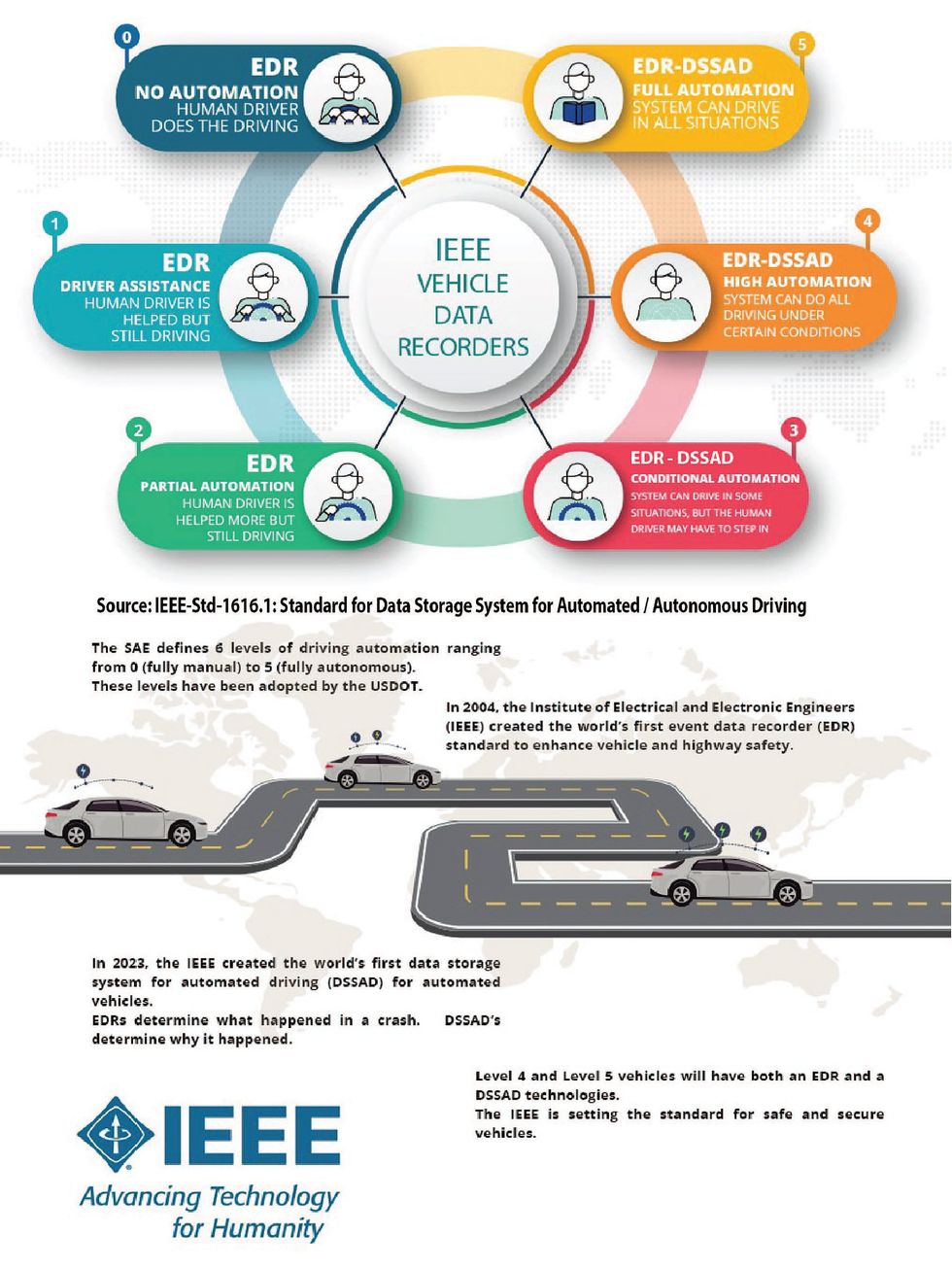When a self-driving automobile is concerned in an accident, its knowledge tells the story—which could be important to crash investigators to find out who or what was at fault, in addition to to automakers, to allow them to make their self-driving methods smarter and safer.
In 2004, the IEEE Requirements Affiliation launched IEEE 1616, setting the bottom guidelines for the categories and quantities of knowledge collected by vehicle event-data recorders, or EDRs (a automobile’s reply to the black packing containers in plane). Within the practically 20 years since this customary was established, nevertheless, autos have grow to be extra electronics-intensive, with the addition of high-tech methods together with superior driver help methods (ADAS) like Tesla’s well-known (and typically notorious) Autopilot.
A brand new customary makes it clear what self-driving-car “black field” knowledge is required—each for crash investigators and for carmakers enhancing their ADAS {hardware} and software program.
So over the previous three years, the 1616 working group has been working to replace the code. IEEE 1616.1, ratified in late June 2023, incorporates new specs for event-data recorders to broaden the dataset out there to autonomous car designers.
The replace “acknowledges the worth of improved crash data in enhancing the information of what occurs earlier than, throughout, and after a motorized vehicle crash,” says Thomas M. Kowalick, chair of the 1616 customary working group and writer of a number of books, together with Deadly Exit: The Automotive Black Field Debate. The usual additionally “seeks to take care of privateness, forestall tampering, keep away from odometer fraud, restrict knowledge entry, and improve security through the use of an occasion knowledge recorder connector lockout equipment.”
Paul Kostek, the working group’s secretary, says the group’s latest emphasis has been on what’s now referred to as the 1616.1–2023 Normal for Information Storage System for Automated Driving (DSSAD). The usual “identifies features and customary technical necessities for knowledge storage necessities.” Kostek, a senior member of IEEE, says it makes clear what knowledge generated by ADAS—those who share the driving activity with people and those who require no human enter—should be accessible for crash investigations and subsequently to be used by software program and {hardware} designers to make enhancements.
All in all, the usual seeks to determine challenges and gaps in figuring out what occurs when a car crashes. The EDR offers “what-happened data,” whereas the information storage system for automated driving offers the “why it occurred data” on the crash website. The DSSAD studies and verifies two important fields, summarizing the standing of the car’s autonomous driving system and who or what—the human driver or the software program—was in management at a particular time limit.
One of many lingering points affecting the event of self-driving car expertise is the shortcoming to reply some basic questions: 1) How will we all know when it’s secure to belief machines to deal with this activity, and a pair of) if a pedestrian is struck by a self-driving car, what ought to occur subsequent? They’re not straightforward to reply, provided that driving entails the doubtless competing objectives of reaching the vacation spot effectively and protecting pedestrians and the occupants of different autos secure. This rigidity known as the Molly downside, the self-driving automobile’s model of the trolley downside, the well-known philosophical thought experiment.
The brand new customary “helps to reply the Molly downside problem,” says Kowalick. By offering exhausting knowledge from visitors phenomena to a large viewers, it is going to assist society resolve if claims of elevated consolation, security, and effectivity are worthwhile.
Loads rides on getting this proper and on doing so expeditiously, says Kowalick. Sometime quickly, he predicts, the annual worldwide loss of life toll related to vehicle journey may very well be lower to a fraction of what we’re witnessing now.
Kostek says the group will doubtless meet once more this fall to deal with “further matters resembling cybersecurity points and knowledge for first responders.” He desires different specialists and stakeholders to know they’re welcome to take part “in direction of creating the following step in automated/autonomous car standardization.”
 IEEE
IEEE
From Your Website Articles
Associated Articles Across the Internet

